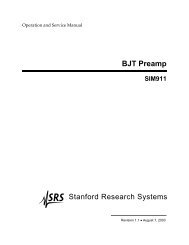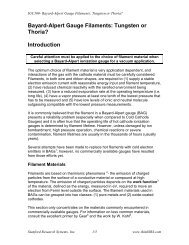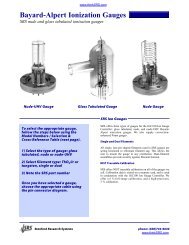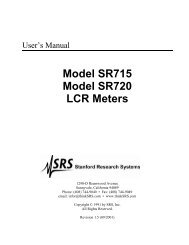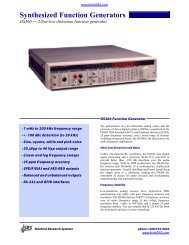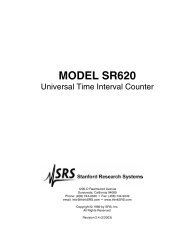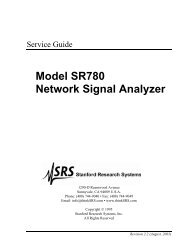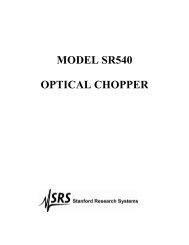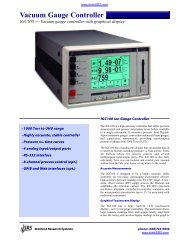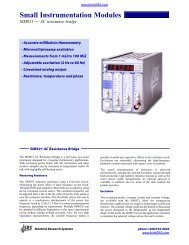Quartz Crystal Microbalance Digital Controller
Quartz Crystal Microbalance Digital Controller
Quartz Crystal Microbalance Digital Controller
- No tags were found...
You also want an ePaper? Increase the reach of your titles
YUMPU automatically turns print PDFs into web optimized ePapers that Google loves.
32 Theory, Operation and Calibration Chapter 2Immersion TestA comparison against the theoretical predictions of equations 6 and 7 is usually a goodstarting point when testing a new experimental liquid QCM200 setup. Two common“checkup” procedures are described.Water ImmersionFor a gold coated, 5 MHz, polished crystal, and assuming that the electrode capacitancehas been properly cancelled, a decrease in frequency of 715 Hz, and an increase inseries resonance resistance of 380 , is expected when switching from air to completeimmersion in water at 20°C.Glycerol/H 2 O ImmersionFigure 22 shows resistance and frequency change values expected for a polished 5 MHzcrystal immersed in a series of viscous glycerol/water solutions at 20ºC. Operation atincreasing glycerol concentrations is an excellent test of a QCM experimental setup, andshould provide predictable results up to more than 88% glycerol.In both procedures, an agreement between measured and expected values within ±25% isgenerally considered acceptable for glycerol concentrations up to 70%.Frequency shifts are much larger (at least a factor of two) and unpredictable forunpolished crystals so they are not recommended for system checkup.Electrochemical <strong>Quartz</strong> <strong>Crystal</strong> <strong>Microbalance</strong>In most electrochemical experiments, mass changes occur as material is deposited or lostfrom the “working” electrode. It is of interest to monitor those changes simultaneouslywith the electrochemical response, and the QCM is the standard means of doing so. As agravimetric probe, the QCM has been used in many types of electrochemical studies,including: underpotential deposition of metals 21 , corrosion, oxide formation, dissolutionstudies 22 , adsorption/desorption of surfactants 23 and changes in conductive polymer filmsduring redox processes 24 .The basic principles and applications of the QCM to electrochemical processes have beenextensively reviewed in the electrochemical literature 25 and will only be discussed brieflyin this manual. Please refer to the publications list at the end of this chapter for moredetailed information.Electrochemical ApparatusA schematic diagram of the apparatus for electrochemical quartz crystal microbalance(EQCM) experiments is given in Figure 23. In this example, a 1 inch diameter, polishedQCM crystal is mounted on a <strong>Crystal</strong> Holder with only one electrode exposed to theconductive solution. The <strong>Crystal</strong> Holder is connected to a QCM25 <strong>Crystal</strong> Oscillator, andQCM200 <strong>Quartz</strong> <strong>Crystal</strong> <strong>Microbalance</strong>



